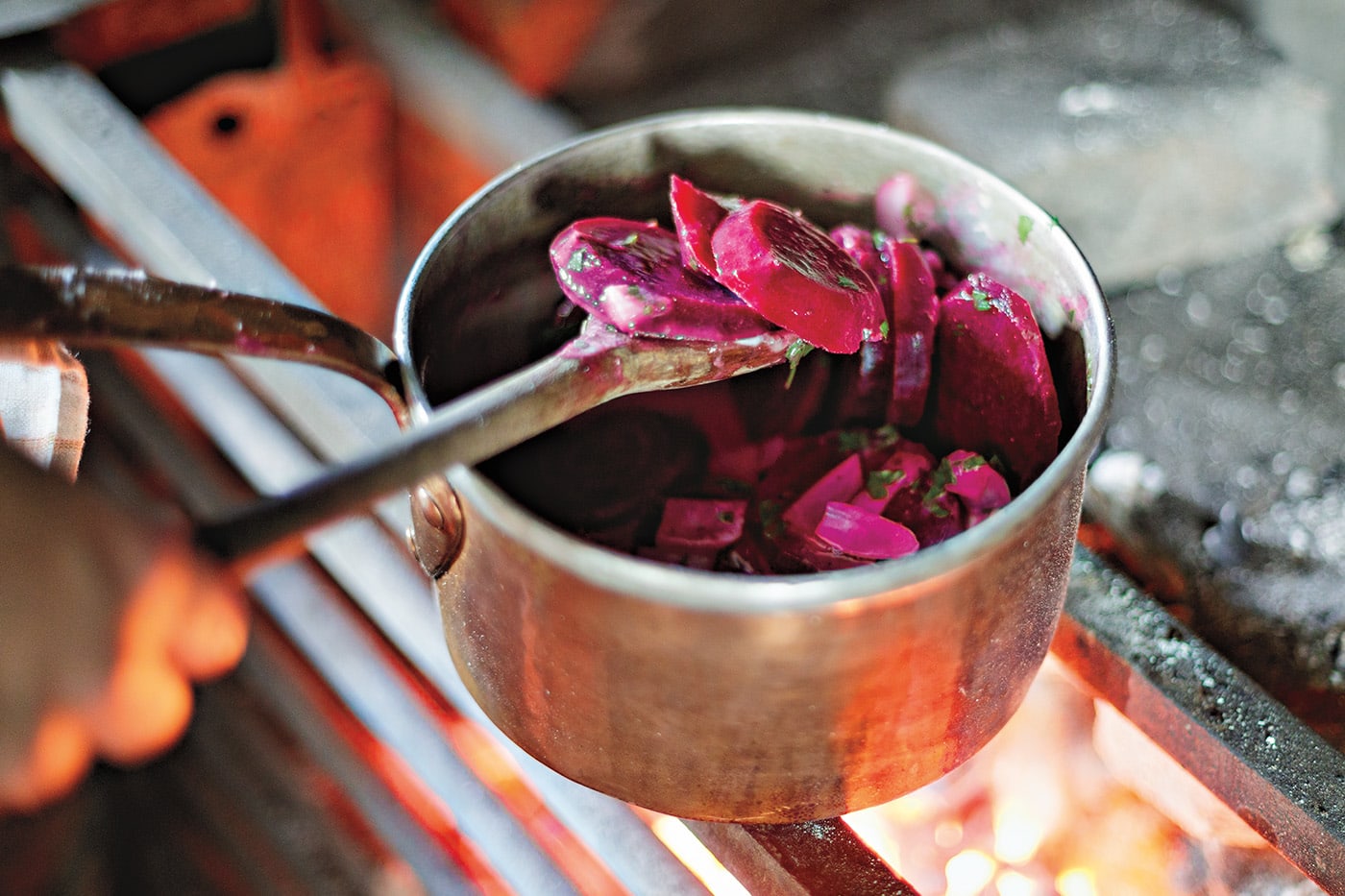Today the nutrition-packed beet is considered a “super food,” credited with everything from lowering blood pressure and increasing energy to fighting inflammation and detoxifying the body. Beets are plentiful at outdoor markets from late summer well into fall.
While the attention being paid to this colorful vegetable is new, beets themselves are not. The leafy vegetable known as Swiss chard is really a form of beet dating back thousands of years, according to Wesley Greene in Vegetable Gardening the Colonial Williamsburg Way. But the red root vegetable with which we are more familiar was first recorded in Germany in 1542. Greene reports the first English description of the red beet refers to it as the “Romaine beet,” suggesting it may actually be another innovation of the Italians, whom he calls “Europe’s consummate vegetable gardeners.”
Greene’s research confirms that beets were found in Colonial kitchen gardens in America, even though they were not as common as carrots, radishes, turnips or parsnips.
“Beets are harvested beginning early in the fall,” said Nicole Justice Green, domestic arts specialist who tends kitchen gardens in Colonial Williamsburg’s Historic Area. “They were easily preserved in root cellars and provided hearty fare to Colonists throughout the long winter.”
Green found several beet recipes in period cookbooks, some with directions as simple as boiling until tender and mashing them like potatoes. The more flavorful recipe she selected is adapted from a 19th-century recipe for stewing beets.
“We offer freshly harvested beets on our menu throughout the summer and well into the fall,” said Travis Brust, executive chef at the Williamsburg Inn. Many of the selections are what one might expect — salads and garnishes that add color and zest to a meal.
But it’s not unusual for Brust to present an unexpected selection: beets as dessert!
“Don’t use red beets for this dish,” he cautions, “or you’ll have ‘red’ everywhere. The color for this recipe comes from late harvest blackberries.”
“Making sorbet from fresh beets is a form of preservation,” Brust said. “It’s not what we typically think of as preserving, like jams and jellies, but by freezing it we’re preserving it for a later date.” The recipe also offers a creative use for the tops of fennel. “No one knows what to do with fennel fronds,” he added.
TO STEW BEETS
Great Hopes Plantation
Serves 4-6. Recipe adapted from Miss Leslie’s Directions for Cookery by Elize Leslie (31st Ed. Philadelphia, 1848). Reprint, Arno Press (New York, 1973).
- 2 pounds fresh beets
- ½ cup chopped onion
- 2 tablespoons minced fresh parsley
- ½ teaspoon salt
- ¼ teaspoon pepper
- ½ cup cider vinegar
- 2 tablespoons butter, softened
- 2 tablespoons flour
HEARTH METHOD:
- Rinse beets thoroughly, then cut the tops, leaving about an inch of stem.
- Barely cover beets with water in an iron pot. Cover, set on crane on hearth and simmer beets until tender, 30 minutes to an hour, depending upon size and age of beets. Remove from fire, drain thoroughly and set aside to cool.
- Put about 1 cup of water in a saucepan set over hot coals. Bring to a boil and add the onion. Cook 5 minutes, drain thoroughly and set aside.
- When beets are cool enough to handle, peel and slice them, which should make about 3 cups. Put them in a saucepan with the onion, parsley, salt, pepper and vinegar. Cover pan and set it over hot coals. Cook gently to heat through, 5-10 minutes.
- Combine butter and flour. Stir into beets and cook gently another 10 minutes or so, stirring often to prevent sticking. Serve hot or cold.
MODERN METHOD:
- Follow hearth directions 1 and 2, simmering beets over moderate heat until tender. In a separate saucepan, parboil onions over moderate heat for 5 minutes. Drain and set aside.
- Complete recipe following hearth directions 4 and 5.
GOLDEN BEET AND LATE HARVEST BERRY SORBET WITH SUGARED FENNEL FRONDS
Williamsburg Inn
Makes ½ gallon (use a juicer to make juice from lemons, beets, berries and orange). Serves 6-8
- 2 lemons, juiced
- 2 cups golden beet juice
- 2 cups blackberry juice
- 1 orange, zested and juiced
- Pinch of kosher salt
DIRECTIONS:
- Heat the sugar, water and lemon juice to dissolve the sugar to make a simple syrup.
- Combine syrup with beet, berry and orange juices and season with kosher salt.
- Freeze mixture according to ice cream machine specifications or spread in baking dish and cover tightly to freeze.
FOR THE SUGARED FENNEL FRONDS
- 1 cup fennel tops, picked into 1-to-2-inch pieces
- 2 cups sugar
DIRECTIONS:
- On a sheet pan, sprinkle one cup of sugar to evenly coat the pan.
- Place fennel tops on top of the sugar.
- Coat the fennel with the second cup of sugar and allow to rest for 30-40 minutes. Garnish the sorbet’s serving dishes with fennel fronds and a sprinkle of berries.
